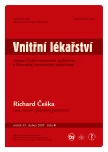Regular aerobic physical activity improves the lipid profile in persons with excessive body weight
Authors:
Z. Stránská 1; M. Matoulek 1; P. Fábin 2; Z. Vilikus 2; Š. Svačina 1
Authors‘ workplace:
III. interní klinika 1. lékařské fakulty UK a VFN Praha, přednosta prof. MUDr. Štěpán Svačina, DrSc., MBA
1; Ústav tělovýchovného lékařství 1. lékařské fakulty UK a VFN Praha, přednosta doc. MUDr. Zdeněk Vilikus, CSc.
2
Published in:
Vnitř Lék 2007; 53(4): 404-407
Category:
Reviews
Overview
A review of physical activity-induced lipid changes is presented. The review was compared with results we obtained in a reconditioning program involving 25 untrained obese patients who attended the reconditioning centre of the 1st Faculty of Medicine of Charles University for three months. A significant decrease was found in both HDL-cholesterol, triglycerides and the atherosclerosis index. No significant changes were recorded in the total and LDL-cholesterol level. Conclusion: Aerobic physical activity can induce changes in lipid levels in overweight and obese patients. Indication of regular aerobic physical activity should not be omitted in current practice.
Key words:
metabolic syndrome – obesity – aerobic exercise – cholesterol – triglycerides – reconditioning centre
Sources
1. Altena TS, Michaelson JL, Ball SD et al. Lipoprotein subfraction changes after continuous or intermittent exercise training. Med Sci Sports Exerc 2006; 38 : 367-372.
2. Barrett LA, Morris JG, Stensel DJ et al. Exercise and postprandial plasma triacylglycerol concentrations in healthy adolescent boys. Med Sci Sports Exerc 2007; 39 : 116-122.
3. Couillard Ch, Després JP, Lamarche B et al. Effects of endurance exercise training on plasma HDL cholesterol levels depend on levels of triglycerides. Arterioscler Thromb Vasc Biol 2001; 21 : 1226-1232.
4. Češka R et al. Cholesterol a ateroskleróza, léčba dyslipidémií. 1. ed. Praha: Triton 2005, 343.
5. Hadaegh F, Harati H, Zabetian A et al. Seasonal variability of serum lipids in adults: Tehran lipid and glucose study. Med J Malaysia 2006; 61 : 332-338.
6. Halverstadt A, Phares DA, Wilund KR et al. Endurance exercise training raises high-density lipoprotein cholesterol and lowers small low-density lipoprotein and very low-density lipoprotein independent of body fat phenotypes in older men and women. Metabolism 2007; 56 : 444-450.
7. Haskell WL Exercise-induced changes in plasma lipids and lipoproteins. Prev Med 1984; 13 : 23-36.
8. Haskell WL The influence of exercise training on plasma lipids and lipoproteins in health and disease. Acta Med Scand Suppl 1986; 711 : 25-37.
9. Hintze J NCSS and PASS. Number Cruncher Statistical Systems. Kaysville (UT, USA) 2001.
10. Jurča R, Stejskal P, Kalina M et al. Vliv věku a pohlaví na výkonnost kardiovaskulárního systému zjištěné pomocí CHR-testu. 272-277. In: Sborník mezinárodní konference Pohyb a zdraví organizované Fakultou tělesné kultury UP. Olomouc: Vydavatelství UP 1999.
11. Knížek J, Stránský P. Příspěvek k nápravě opomíjení významu síly testů ve studiích z experimentální medicíny. ČLČ 2005; 2 : 56-58.
12. Nagi D. Exercise, Metabolic syndrome and type 2 diabetes. In: Nagi D et al. Exercise and sport in diabetes. 2. ed. Chichester (UK): John Wiley&Sons 2005 : 218.
13. Olchawa B, Bronwyn AK, Anh H et al. Physical fitness and reverse cholesterol transport. Arterioscler Thromb Vasc Biol 2004; 24 : 1087-1091.
14. Ring-Dimitriou S, von Duvillard SP, Paulweber B et al. Nine months aerobic fitness induced changes on blood lipids and lipoproteins in untrained subjects versus controls. Eur J Appl Physiol 2007; 99 : 291-299.
15. Salinger J, Vychodil R, Stejskal P et al. Příklady řešení modelových situací diagnostickým systémem variacardio TF 4, 455-459. In: Sborník mezinárodní konference Pohyb a zdraví organizované Fakultou tělesné kultury UP. Olomouc: Vydavatelství UP 1999.
16. Svačina Š et al. Metabolický syndrom. 3. ed. Praha: Galén 2006.
17. Svačinová H. Role pohybové léčby a tělesné zdatnosti v prevenci a léčbě metabolického syndromu. Vnitř Lék 2005; 51 : 87-92.
18. Tchernof A, Després JP. Obesity and lipoprotein metabolism. In: Kopelman PG, Stock MJ Clinical obesitology. 1. ed. MÍSTOBlackwell Science, England 1998, 631.
19. Thompson PD, Cullinane EM, Sady SP et al. High density lipoprotein metabolism in endurance athletes and sedentary men. Circulation 1991; 84 : 140-152.
20. Vaverková H, Soška V, Rosolová H et al. Doporučení pro diagnostiku a léčbu dyslipidemií v dospělosti, vypracované výborem České společnosti pro aterosklerózu. Vnitř Lék 2007; 53 : 181-197.
21. Vilikus Z, Brandejský P, Novotný V. Tělovýchovné lékařství. 1. ed. Praha: Karolinum 2004.
22. Yalin S, Gok H, Toksoz R. The effect of the short-term regular exercise-diet program on lipid profile in sedentary subjects. Anadolu Kardiyol Derg 2001; 1 : 179-188.
Labels
Diabetology Endocrinology Internal medicineArticle was published in
Internal Medicine

2007 Issue 4
Most read in this issue
- Lipoprotein (a)
- How corticoids, growth hormone and oestrogens influence lipids and atherosclerosis
- Side effects of pharmacotherapy on lipid levels
- Can reduction in resting heart rate be beneficial for patients?
